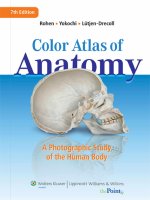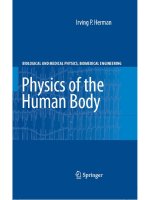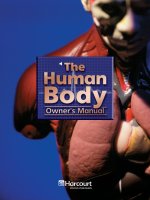4 5 systems of the human body (life science)
Bạn đang xem bản rút gọn của tài liệu. Xem và tải ngay bản đầy đủ của tài liệu tại đây (4.25 MB, 14 trang )
Life Science
Genre
Nonfiction
Comprehension Skill
Draw Conclusions
Text Features
•
•
•
•
Labels
Captions
Text Boxes
Glossary
Science Content
Body Systems
by Abby Roberts
Scott Foresman Science 4.5
ISBN 0-328-13871-1
ì<(sk$m)=bdihbf< +^-Ä-U-Ä-U
Vocabulary
What did you learn?
immune system
1. What is one mineral that bones need? Why do bones
need this mineral?
by Abby Roberts
infectious disease
involuntary muscles
neuron
pathogens
vaccine
Systems of the Human Body
2. What are the important parts of the central nervous
system?
3. What do white blood cells do?
4.
The human body needs oxygen
to survive. On your own paper, write to explain how
oxygen enters and moves through the body. Use details
from the book to support your answer.
5.
Draw Conclusions Your ribs are bones. They
protect your body’s organ systems. Which systems
do they protect? Why is it important to protect these
systems?
voluntary muscles
Illustration: Title Page, 5, 7, 9, 13, 15, 17, 19 Big Sesh Studios
Photographs: Every effort has been made to secure permission and provide appropriate credit for
photographic material. The publisher deeply regrets any omission and pledges to correct errors called to its
attention in subsequent editions. Unless otherwise acknowledged, all photographs are the property of Scott
Foresman, a division of Pearson Education. Photo locators denoted as follows: Top (T), Center (C), Bottom
(B), Left (L), Right (R) Background (Bkgd)
Opener: ©Dr. Dennis Kunkel/Visuals Unlimited; 2 (CR) ©Dr. Donald Fawcett/Visuals Unlimited, (Bkgd)
©Dr. Richard Kessel & Dr. Randy Kardon/Tissues and Organs/Visuals Unlimited, 3 ©Prof. P. Motta/Univ.
“La Sapienza”/Photo Researchers, Inc.; 4 (TL) ©Science Photo Library/Photo Researchers, Inc., (BL)
©CNRI/Photo Researchers, Inc.; 6 (CL) ©Innerspace Imaging/Photo Researchers, Inc., (BL) ©SPL/Photo
Researchers, Inc., (BL) ©Dr. Donald Fawcett/Visuals Unlimited; 10 Getty Images; 11 ©Scott Camazine/
Photo Researchers, Inc.; 17 ©Alfred Pasieka/Photo Researchers, Inc.; 18 ©Prof. P. Motta/Dept. of
Anatomy/University “La Sapienza”, Rome/Photo Researchers, Inc.; 19 ©Susumu Nishinaga/Photo
Researchers, Inc., 20 ©Quest/Photo Researchers, Inc.; 21 (B) ©Dr. Kari Lounatmaa/Photo Researchers,
Inc., 21 ©Dr. David M. Phillips/Visuals Unlimited 22 (TL, CC, CL, BL) ©Bettmann/Corbis; 23 (TL, TR) ©Dr.
Donald Fawcett & E. Shelton/Visuals Unlimited
ISBN: 0-328-13871-1
Copyright © Pearson Education, Inc.
All Rights Reserved. Printed in the United States of America. This publication is
protected by Copyright and permission should be obtained from the publisher prior
to any prohibited reproduction, storage in a retrieval system, or transmission in any
form by any means, electronic, mechanical, photocopying, recording, or likewise. For
information regarding permissions, write to: Permissions Department, Scott Foresman,
1900 East Lake Avenue, Glenview, Illinois 60025.
3 4 5 6 7 8 9 10 V010 13 12 11 10 09 08 07 06 05
What are the skeletal
and muscular systems?
Parts of Organ Systems
Your body is made of many kinds of cells. Cells that are alike
work together. These cells make up tissues.
Tissues that work together make up organs. Each organ does
a different job. Your heart is an organ. The muscle, nerve, and
connective tissues in your heart work together to pump blood.
A group of organs that work together is an organ system. The
heart and blood vessels are part of the circulatory system. All
parts of an organ system are important. Damage to any organ
in the system will affect the other organs in the system.
The different organ systems in your body work together.
What happens when you go inline skating? Your skeletal and
muscle systems help you stand and move. Your nervous system
controls your movement. Your muscles get energy from your
respiratory and circulatory systems.
These tissue cells can only be
seen through a microscope.
2
3
Types of Joints
Your shoulders and hips
have ball-and-socket
joints. A bowl-shaped
area of a bone holds the
end of another bone in
place. This joint allows
your leg to move in a
circle.
The Skeletal System
The Human Skeleton
Your skeleton is made mostly of
bone tissue. Your skeleton holds
up your body. It also protects your
organs. Your ribs are bones that
protect your heart. Your skeleton
helps you move. Your muscles are
attached to your bones.
There are 206 bones in an adult skeleton. Bones are
different shapes and sizes. The shape of a bone has to do
with its job.
Clavicle
(collarbone)
Cranium
(skull)
Scapula
(shoulder blade)
Sternum
(breastbone)
Building Strong Bones
Your knees and elbows
have hinge joints. These
joints help you move
your bones back and
forth. Hinge joints allow
you to bend or straighten
your legs.
Bones need minerals. Calcium
is a mineral that helps make new
bone tissue. It keeps bones strong.
Calcium also helps other tissues
work well.
Many bones make different kinds
of blood cells. Some blood cells help
keep you from getting sick. Others
help bleeding stop when you are cut.
Bones are attached to each other
at the joints. Tissues are around
joints. Tissues protect them. Tissues
also keep bones together.
Humerus
Vertebrae
(backbone)
Radius
Ribs
Pelvis
(hipbone)
Ulna
Femur
Carpals
(wrist bones)
Phalanges
(finger bones)
Patella
(kneecap)
Fibula
Tibia
(shinbone)
Tarsals
(ankle bones)
Phalanges
(toe bones)
4
5
The Muscular System
Involuntary Muscles
Muscles help the bones in your body move. Muscles help you
breathe, swallow, walk, and smile.
Other muscles are called involuntary muscles.
Involuntary muscles work whether you tell them to or not.
Involuntary muscles help you breathe. They help keep blood
moving in your body.
Voluntary Muscles
Most of your muscles are voluntary muscles. Voluntary
muscles are those that you can choose to move. When you
smile, run, and chew, you use voluntary muscles.
Many of your voluntary muscles are attached to bones. They
are called skeletal muscles. They work in pairs. For example,
two muscles work together in your arm. When you bend your
arm, one muscle contracts, or gets shorter. The other muscle
relaxes. When you straighten your arm, the first muscle
relaxes. Then the other muscle contracts.
Skeletal muscles are fastened to your
bones. They may look striped.
Your body has more than
600 different skeletal muscles.
Abdominal
muscles
(flatten
abdomen)
Biceps
(bend
arm)
Smooth muscles are involuntary
muscles. They are part of many
organs in your body.
Inner thigh
muscles
(turn leg)
Cardiac muscles are also involuntary
muscles. They are found only in the
heart. They may also look striped.
6
Chest muscles
(pull arm
toward chest)
Back muscles
(draw arm up
and back)
Trapezius
(raises the
shoulder)
Triceps
(straighten
arm)
Gluteus
maximus
(extends leg)
Calf muscles
(bend leg)
7
What are the respiratory
and circulatory systems?
The Respiratory System
Human beings need oxygen to stay alive. Oxygen is a gas
in the air. When you breathe, air enters your nose and mouth.
It moves into your throat, or pharynx. Then air travels into a
tube called the windpipe, or the trachea. The trachea splits into
two smaller tubes called bronchial tubes. Air goes through the
bronchial tubes into your lungs.
In your lungs, bronchial tubes split into many tiny tubes.
Each tiny tube leads to an air sac. Tiny blood vessels are around
each air sac. Oxygen moves from the air in each sac into these
blood vessels. Then the blood carries oxygen to all the cells in
your body.
Take a Breath!
The cells in your body use oxygen. They give off the gas
carbon dioxide. As you breathe out, the carbon dioxide leaves
your body.
The lungs are organs. They help move gases in and out of
your body. Lungs do not have muscles. A muscle called the
diaphragm is just below your lungs. The diaphragm has the
shape of a dome. When your diaphragm tightens, it pulls air
into your lungs. When it relaxes, the air is pushed out.
Pharynx
Trachea
Air sac
Bronchial tubes
Lungs
Diaphragm
8
9
How Pumps and Passages
Work Together
The respiratory and circulatory
systems work together. They bring
oxygen into your body. They take
carbon dioxide out of your body.
You breathe in oxygen using your
respiratory system. The oxygen goes
into the air sacs in your lungs. From
there it passes into your blood.
You breathe in
oxygen. This oxygen
goes into your blood.
Your blood carries
oxygen throughout
your body.
Your heart is
one part of your
circulatory system.
The drawing is a
model of a
human heart.
Blood vessels bring the blood with oxygen to your heart.
Then your heart pumps blood to the rest of your body. The
blood brings oxygen to the cells of your body.
Your circulatory system moves blood through your body. The
parts of this system are your heart, blood vessels, and blood.
10
11
An Amazing Pump
The heart has a right side and a left side. Each side
works as a pump. The right side gets blood from your
body. This blood has carbon dioxide from your cells. The
heart pumps this blood to your lungs. When you breathe
out, the carbon dioxide goes out of your body.
The left side of the heart gets blood from your lungs.
This blood is full of oxygen. The heart pumps it to all the
cells in your body.
A muscle separates the two sides of your heart and
the blood in each side. The blood coming into the heart
doesn’t get mixed with the blood going out of it.
Your heart has two chambers on each side. They are
the atrium and the ventricle. The atrium on the right
side of the heart takes in carbon dioxide-rich blood. The
atrium on the left side of the heart takes in oxygen-rich
blood. Blood moves from the atrium through a one-way
valve into the ventricle. The blood in the right ventricle
is pumped to the lungs. The blood in the left ventricle
is pumped to the rest of the body.
Blood from the body
enters the right side
of the heart.
The right pump sends
carbon dioxide-rich
blood to the lungs.
There the carbon
dioxide will leave
the body, and oxygen
will be taken in.
Blood from the
lungs enters the left
side of the heart.
Large blood vessels
bring carbon
dioxide-rich blood
from the body to the
right side of the heart.
12
The left pump sends
oxygen-rich blood
into the body.
Large blood vessels take
oxygen-rich blood from
the left side of the heart
to the body.
13
What are the digestive
and nervous systems?
The Digestive System
Is pizza one of your favorite foods?
Pizza, or any food that you eat, must
be broken down into nutrients. Your
digestive system does this job. It
digests, or breaks down, all the food
that you eat.
Digestion starts when you take a
bite of food. The food moves through
the organs of the digestive system.
These organs break the food down into
important nutrients. The nutrients pass
into the blood vessels. Blood carries them
to your body’s cells.
Your teeth and saliva break
down food.
Next, you swallow the food. It
goes down a tube. The tube is your
esophagus. Muscles push the food
into your stomach.
Your stomach has smooth muscles
that grind up the food. The food
mixes with juices in your stomach.
It turns into thick liquid. The liquid
goes into a very long tube called
the small intestine. More juices are
mixed in.
The juices in the small intestine
break the food into important
nutrients. These nutrients move into
the blood vessels. Blood carries the
nutrients to the cells in the body.
Some parts of food are not broken
down. These parts move into the
large intestine. They are turned
into waste. Waste from food
leaves the body.
14
15
The Central Nervous System
Your body has a control center. It is
the central nervous system. The brain
and spinal cord are the important parts
of this system.
The central nervous system brings
messages from one organ to another.
It controls your breathing, your
heartbeat, and the movement of
your muscles.
The central nervous system gets
information from organs such as your
eyes, ears, nose, and tongue. Suppose
you hear a friend yell “Catch!” You see
the ball. Your brain tells your muscles
to reach for it. This happens because of
your central nervous system.
The Spinal Cord
Your spinal cord joins your brain to
the rest of your body. Layers of tissue
cover and protect it. Your brain decides
what your body should do. Then it
sends messages through your spinal
cord. Sometimes your spinal cord reacts
before you even think about what to
do. For example, you don’t think about
blinking your eyes. You just do it!
16
The spinal cord
links your brain
and other parts
of your body.
The brain is a moist, spongy organ
made up of billions of nerve cells.
The Brain
Your brain is an organ. It is made up of billions of
nerve cells. The layers of tissue that cover and protect
the spinal cord also cover and protect the brain. The
skull, as well as a watery liquid inside it, also help
keep the brain safe.
Neurons
A neuron, or a nerve cell, is the basic unit of
the nervous system. A nerve is made of a bunch of
neurons. Many bunches of neurons make up the
spinal cord. Neurons carry information. They send
signals to and from the brain.
Every neuron has a cell body and a nucleus. The
cell body has two kinds of parts sticking out of it. One
kind carries signals toward the neuron. The other
kind carries signals away.
Neuron
17
How does the body
defend itself?
Microorganisms in Your Body
When you get a cut, you clean it. Then you cover it with
a bandage. That way, the cut will not get infected. It can get
infected if organisms that cause disease get into the cut. Most
of these organisms are so small that you need a microscope
to see them. They are called microorganisms.
Some microorganisms live in your body all the time.
They are not harmful. Some are on your skin and
others are in your mouth.
Your Body’s Defenses
Some microorganisms are harmful. Your body has cells,
tissues, and organs that work to protect you.
Your skin protects you. For example, there are acids in your
sweat. These acids kill many harmful microorganisms that
might make you sick.
The tears in your eyes and the saliva in your mouth also
protect you. Tears wash away harmful microorganisms in your
eyes. Saliva catches microorganisms in your mouth and washes
them away.
Tightly packed skin
cells cover your body.
Thick, slippery mucus in
your throat, nose, and
lungs traps dust and many
microorganisms you breathe
in. Coughing or swallowing
removes the mucus and
microorganisms.
Acids in your stomach
will kill many
disease-causing
organisms.
18
19
Bacteria and Viruses
Staying Healthy
Organisms that cause disease are called pathogens. If
pathogens get into your body, more of them will grow. They
will form an infection in your body, making you sick.
An illness that is caused by pathogens is called an
infectious disease. An infectious disease spreads from one
organism to another. If you have pathogens in your body,
you can get an infectious disease. Then you may give it to
someone else.
Two kinds of pathogens are bacteria and viruses. Viruses
are tiny; they are much smaller than bacteria. They use cells
in your body to make more viruses. Different viruses attack
different cells. For example, some attack the cells in your nose,
mouth, and throat. Then you get a cold.
Some harmful microorganisms move though the air. You
should cover your mouth and nose when you cough or sneeze.
Then you won’t send microorganisms through the air to
someone else.
If you touch an object that has microorganisms living on it,
and then you put your hands near your mouth, you can get
sick. That’s why it is important to wash your hands before you
eat. Also, make sure that objects such as towels, dishes, and
glasses are clean before you use them.
Strep throat is an infection caused by
bacteria. These bacteria make a
poison that infect the throat and
the surrounding tissues.
Colds and influenza are
caused by viruses.
Food may contain harmful bacteria
that make people sick. Many
cases of food poisoning
are caused by bacteria
called E. coli.
20
21
How Your Body Fights Infections
Many years ago, people began to learn about infectious
diseases. They learned why people got sick. They also learned
how to protect people from getting sick.
1796
Edward Jenner did tests with material he got
from a sore. He used it to make a vaccine
against smallpox.
1854
Attacking the Invaders
Florence Nightingale worked as a nurse
during wartime. She made sure that people
kept hospitals clean.
The immune system helps protect you against pathogens.
Blood cells and other tissues make up your immune system.
White blood cells make antibodies to stop pathogens. An
antibody is a chemical. It keeps pathogens from infecting other
cells. Your immune system uses antibodies that you already
have to fight infection.
1868
Louis Pasteur found out that microorganisms
make people sick. He found a way to kill some
microorganisms.
1882
Robert Koch discovered a kind of pathogen. He
also discovered that each pathogen would cause
a different infectious disease.
1928
Preventing the Disease
A vaccine is a kind of medicine that protects you from a
disease. It can make you immune to a disease. The vaccine
helps make special antibodies to kill the pathogens.
All the systems of your body work together. Your skeletal and
muscular systems help you move. Your digestive, circulatory,
and respiratory systems bring your cells what they need. Your
nervous system controls your body. Your immune system
protects you from sickness.
Alexander Fleming discovered a fungus called
penicillin. Then he found out that penicillin kills
bacteria.
22
23
Vocabulary
Glossary
immunesystem
system
immune
What did you learn?
the system that helps protect you
against pathogens
1. What is one mineral that bones need? Why do bones
need this mineral?
infectious disease
an illness that is caused
by pathogens
involuntary muscles
neuron
2. What are the important parts of the central nervous
system?
muscles that do their jobs without
you having to think about it
infectious disease
involuntary muscles
pathogens
neuron
vaccine
one of the cells forming the brain,
spinal cord, and nerves; nerve cell
pathogens
voluntary
muscles
organisms that cause disease
vaccine
a medicine that protects you from
a disease
voluntary muscles
muscles that you can choose
to move
Illustration: Title Page, 5, 7, 9, 13, 15, 17, 19 Big Sesh Studios
Photographs: Every effort has been made to secure permission and provide appropriate credit for
photographic material. The publisher deeply regrets any omission and pledges to correct errors called to its
attention in subsequent editions. Unless otherwise acknowledged, all photographs are the property of Scott
Foresman, a division of Pearson Education. Photo locators denoted as follows: Top (T), Center (C), Bottom
(B), Left (L), Right (R) Background (Bkgd)
Opener: ©Dr. Dennis Kunkel/Visuals Unlimited; 2 (CR) ©Dr. Donald Fawcett/Visuals Unlimited, (Bkgd)
©Dr. Richard Kessel & Dr. Randy Kardon/Tissues and Organs/Visuals Unlimited, 3 ©Prof. P. Motta/Univ.
“La Sapienza”/Photo Researchers, Inc.; 4 (TL) ©Science Photo Library/Photo Researchers, Inc., (BL)
©CNRI/Photo Researchers, Inc.; 6 (CL) ©Innerspace Imaging/Photo Researchers, Inc., (BL) ©SPL/Photo
Researchers, Inc., (BL) ©Dr. Donald Fawcett/Visuals Unlimited; 10 Getty Images; 11 ©Scott Camazine/
Photo Researchers, Inc.; 17 ©Alfred Pasieka/Photo Researchers, Inc.; 18 ©Prof. P. Motta/Dept. of
Anatomy/University “La Sapienza”, Rome/Photo Researchers, Inc.; 19 ©Susumu Nishinaga/Photo
Researchers, Inc., 20 ©Quest/Photo Researchers, Inc.; 21 (B) ©Dr. Kari Lounatmaa/Photo Researchers,
Inc., 21 ©Dr. David M. Phillips/Visuals Unlimited 22 (TL, CC, CL, BL) ©Bettmann/Corbis; 23 (TL, TR) ©Dr.
Donald Fawcett & E. Shelton/Visuals Unlimited
ISBN: 0-328-13871-1
Copyright © Pearson Education, Inc.
All Rights Reserved. Printed in the United States of America. This publication is
protected by Copyright and permission should be obtained from the publisher prior
to any prohibited reproduction, storage in a retrieval system, or transmission in any
form by any means, electronic, mechanical, photocopying, recording, or likewise. For
information regarding permissions, write to: Permissions Department, Scott Foresman,
1900 East Lake Avenue, Glenview, Illinois 60025.
3 4 5 6 7 8 9 10 V010 13 12 11 10 09 08 07 06 05
24
3. What do white blood cells do?
4.
The human body needs oxygen
to survive. On your own paper, write to explain how
oxygen enters and moves through the body. Use details
from the book to support your answer.
5.
Draw Conclusions Your ribs are bones. They
protect your body’s organ systems. Which systems
do they protect? Why is it important to protect these
systems?









